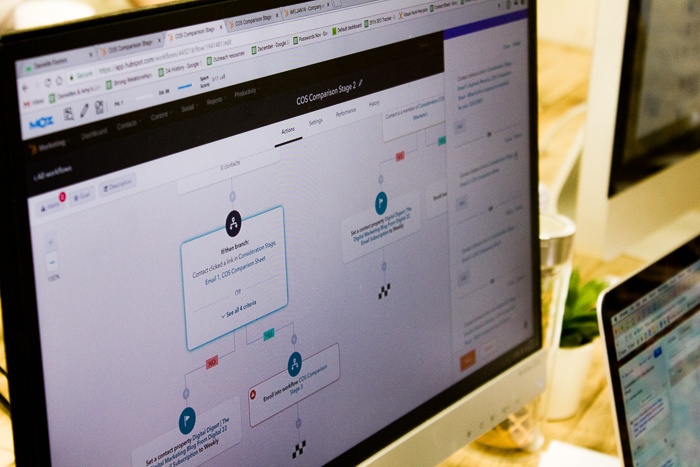Workflows are under appreciated and to some marketers, they may seem like a long winded task. I...
Marketers can’t be blamed for assuming that creating workflows are a long-winded task. In reality, though, they’re heavily underappreciated when you consider the role they play in helping to nurture customers. In fact, any successful Inbound Marketing strategy should be using email automation workflows considering they have so many benefits. Here’s how you can plan and writing an Inbound Marketing email workflow for yourself.

Your workflow emails are sent once your content offering, such as an eBook or pillar page, has been downloaded. To help make the planning and writing process simpler, we’ve broken it down into three sections. These proven phases are what we use in our internal processes, so just click on any of the below to read more about what you should be writing during that stage of the workflow.
Education
An Overview
The workflow emails you send in the education stage is the very first time you’ll contact a lead who has downloaded your content. Here, it’s all about providing them value. Don’t make the crucial error of mentioning your company, the service you offer or the products you sell.
Instead, make sure you continue to talk about the download topic they’ve shown an interest in. Also, offer more help and tips that add serious value and are actually helpful and relevant to them.
What to Include
As mentioned, these workflow emails are the very first ones you’ll send out so they’re going to be the most engaging ones, so make sure you’re putting plenty of effort in it. The content within these workflows need to have all of the resources and that’s vital. Don’t just say, ‘Thanks for downloading and we’ll get in touch soon.” You’re probably just wasting a valuable email which can do more harm than good.
Your lead is most likely to take action here, which is quite obvious as they’ve just downloaded your offer. So, write something along the lines of “Here’s your guide, but why not check out…” and them offer them something else which is relevant. It might be a webinar or if you have the resources and a catalogue full of content, tell them to check out your top five blogs on that particular topic, for example.
If you don’t have the resources available, that’s still OK. Lead by telling them that you have their guide in the email and maybe throw in a bit of extra useful content which you didn’t manage to fit in the download piece. It’s all about packing in that value to keep them from hitting the unsubscribe button.
The Aim
The overall aim of the workflow emails at this stage is to keep your leads subscribed, happy and provide maximum value. Don’t offer anything too heavy, just get them thinking, “I have something useful here, but I’m not getting spammed. I like them and I want more emails.”
If you’re using HubSpot, you can even check to see if they’re engaged with this phase of emails before enrolling in the next stage of workflows.
Struggling with workflow email ideas? Don’t worry, we’ve got you covered. Check out our blog on three workflow email ideas you can easily use, how they help and how to implement them:
3 Workflow Email Ideas to Use This Week
Education and Empathy
An Overview
Like the previous stage of workflow emails, this phase also shouldn’t mention your company. However, the key difference here is that you can begin to mention the product or service you’re offering. In other words, the ways in which you can solve their pain points.
What to Include
In these workflow emails, you can now start to play on all of their pain points. Think general pain points of your persona such as costs, making big decisions, needing to convince their boss, managing a team - whatever their pain points may be.
However, the content here is broader now as all of this comes from persona documents and this should stay static, you don’t need to continue talking about the download. So, make one set of these for each persona and every time you make a guide, you should lead to this.
Leads need to think that you understand them and you’re there for them. You even understand the targets they need to meet and the challenges they need to overcome and repeat that for the other workflow emails in this phase. It’s about levelling with them here, make the readers understand that you know what you’re doing because you agree with them.
You might also have another middle of the funnel download to get them to convert again and get more engagement, but that’s not necessary if you don’t have anything available.
The Aim
The aim of your workflow emails in this phase is to show readers that you understand their position and what their challenges are. Also, you have a solution you’d like to share with them to help their challenges.
Empathy and Action
An Overview
The third and final phase of the email workflow process is where you can finally talk about yourself without making it sound like you’re coming on too strong. If leads are at this stage now, they’re probably expecting to hear from someone at last.
They wouldn’t want to find out anything about you earlier than this. They just wanted solutions to pain points and now that you’ve offered it to them, it’s time to introduce yourself.
What to Include
Up until this point, you’ve shown that you understand them. So things you’ll need to include in your workflow emails now revolves around your company. Think along the lines of prestigious awards you’ve received, what you’re trusted and experienced in and testimonials - anything that tells the reader that you’re an industry leader. Also, if you have social proof, give them that too.
You need to try and get the readers to think, “Maybe these guys can solve these pain points” and that can be done through the use of everything highlighted above. At this stage, you can even bring in emails from your sales team and ask the leads if they want to talk or reply with questions of their own.
By now, they should be engaged enough to take action so it’s the perfect time to ask for a conversation or engage with bottom of the funnel download, such as a demo or pricing. You don’t need to worry about selling during these emails - you’re at this stage now because you’ve given them everything possible.
Some of your leads might even stop and go straight to sales if they have time, but it could be beneficial to send them some useful information like the location and size of your company, the sectors you specialise in and so on. This gives them a better idea of what your company is all about.
The Aim
The aim of your workflow emails during this phase is pretty straightforward. You need to generate a conversation or give your sales team the opportunity to call them with permission.
Why You Don’t Need to Automate Everything
Another useful tip for you to consider before you go off to plan and write your own workflow emails is that not all of your workflow emails need to be automated. While automation does eliminate plenty of headaches and can ease workload, the decisions that your leads make might mean they need to enter a different phase of the workflow.
Automation depends on when readers need more information and persuasion to stay with you. If they’re not taking the relevant action, they’ll get another email to persuade them further. If they do what’s required, such as contacting your sales team right away, then you can manually bring them in at the end of your workflows, for example.
Whenever you create a new campaign, decide if you need to do full automation, a couple of bits or no automation at all.
There’s More to Workflow Emails
Believe it or not, the above was just a basic, linear example of what workflow emails look like and how you can get started. One of the more in-depth ways to make your automation really nurture and segment your database is by using branching workflows in HubSpot.
You’re able to create all sorts of yes/no and if/then branches and this helps to further develop distinct nurturing experiences for your contacts. You can have your contacts follow one path or another and that all depends on an action within your workflow.
For example, if you send out an email, you can have that contact receive different content depending on if they clicked a link in the email or not.
By using branching logic in your workflow emails, you can develop an even better nurturing experience for your contacts depending on their behaviour so that you can achieve your workflow’s main goals.
Find Out More About All Things Inbound Marketing
Just like there’s a higher-level when it comes to workflow emails, the same can be said for Inbound Marketing. There’s a lot more you need to know about workflows, campaigns, the new Flywheel, video marketing and so much more. That’s why we’ve created an Inbound Marketing guide to help boost your marketing efforts.
There’s a lot to get through so to make it easier, we’ve created an easy-to-read guide on all things Inbound Marketing.



